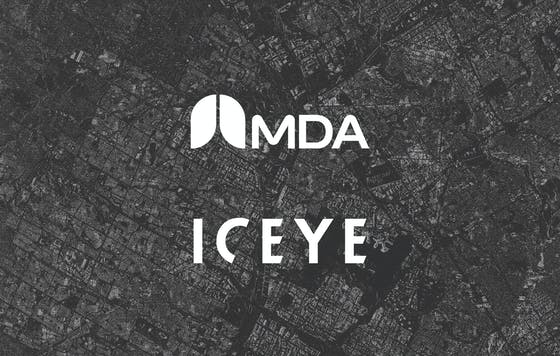
Following extensive analysis, MDA selects the best of New Space X-band providers to combine with its world-leading C-band radar capability
MDA Ltd. (TSX:MDA) and ICEYE today announced at the World Satellite Business Week event that they have entered into an agreement for ICEYE to supply an X-band Synthetic Aperture Radar (SAR) spacecraft for CHORUS, MDA’s next generation commercial Earth observation mission. A collaborative multi-sensor constellation, CHORUS brings together diverse and unique imagery and data sources, changing how and when we see the world by providing a new level of real-time insight and innovative Earth observation services.
Building on the legendary RADARSAT program, CHORUS will include C-band and X-band SAR satellites operating in a unique mid-inclination orbit with day or night imaging in all weather conditions. An essential element of the CHORUS constellation, the X-band spacecraft will fly in the same mid-inclination orbit with the identical ground track as the MDA-built C-band SAR satellite.
This revolutionary approach will provide the most extensive radar imaging capacity available on the market, with higher imaging performance, higher frequency imaging, variable imaging times, more imaging time per orbit, fast tasking, faster delivery timelines and Near Real-Time (NRT) data exploitation aided by machine-learning and artificial intelligence.
Adding a trailing high-resolution X-band SAR satellite to a powerful C-band SAR satellite will also unlock new use cases, including tipping and cueing techniques that allow MDA’s leading broad area sensor to monitor an area of interest (the “tip”) and to zoom in on objects of interest (the “cue”) using the trailing high resolution sensor.
Combining C-band and X-band capabilities, CHORUS will significantly enhance existing services and enable new applications not feasible with existing SAR satellites. Features include:
● Designed with a focus on maritime surveillance applications, CHORUS will have dedicated vessel detection imaging modes with an imaging capacity to collect an area equal to 40% of the global Exclusive Economic Zones (EEZ) – or over 55 million square kilometres – every day using the 25m Vessel Detection Mode.
● CHORUS will enable a new level of precision all-weather satellite monitoring of icebergs in the North Atlantic. This is currently achieved by crewed aircraft observations supplemented with Earth observation satellite imagery.
● The mission will enable tipping and cueing operations between wide area surveillance to high-resolution point target monitoring. This unique capability is especially useful, when fused with space-based Automatic Identification System (AIS) data, for use cases such as broad area ship detection and vessel classification to support dark vessel detection activities.
● The X-band satellite will operate in a trailing orbit which will enhance image correlation, allowing for more effective image fusion, measurements, exploitation and event or object characterization.
The companies also announced that they have signed a separate distribution agreement that will allow MDA to sell ICEYE’s existing and future X-band data to select RADARSAT-2 customers as well as to develop value-added products to immediately take advantage of advanced information data integration and analytics from these two types of SAR sensors.
MDA owns and operates RADARSAT-2, one of the world’s most capable commercial broad-area imaging satellites. With over 20 imaging modes, and established customers in over 45 countries, RADARSAT-2 delivers operationally reliable products and services supporting a number of use cases, including marine surveillance, ice monitoring, disaster management, environmental monitoring, resource management and mapping.
ICEYE operates the world’s largest commercial constellation of SAR satellites and has launched 14 spacecraft to date. The company is planning to further expand its constellation with at least four additional satellites by mid-2022, with the objective of reaching an average access time of three hours anywhere on the globe.




Be the first to comment